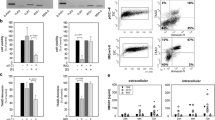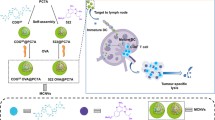Abstract
Previously, we demonstrated that treatment with E7(44–62) and the adjuvant polyinosinic-cytidylic acid (poly(I:C)) in a rodent model generates antitumor immune responses, but the effect of E7(44–62) with poly(I:C) on natural killer (NK)- and dendritic cell (DC)-mediated antitumor activities is still unclear. Our goal was to examine the antitumor effects of E7(44–62) with poly(I:C). We examined the ability of E7(44–62) with poly(I:C) to induce toll-like receptor 3 (TLR3) expression, tumor necrosis factor-alpha (TNF-α) and interferon-gamma (IFN-γ) mRNA expression, and tumor cell-killing activity in human NK cells as well as its ability to induce CD11c and CD86 expression and proliferation in human DCs. We found that E7(44–62) with poly(I:C) treatment markedly increased TLR3 expression and cytotoxicity against HeLa cells in human NK92 cells. Moreover, treatment with E7(44–62) and poly(I:C) markedly up-regulated IFN-γ and TNF-α mRNA expression in NK92 cells. Human patients with cervical cancer exhibited a marked decrease in the frequency of DCs; however, ex vivo treatment with E7(44–62) and poly(I:C) restored DC frequency. Stimulation of human DCs in patients with E7(44–62) and poly(I:C) led to high levels of CD11c and CD86 expression. Our data reveal the involvement of E7(44–62) combined with poly(I:C) in potentiating antitumor cytotoxicity and cytokine-producing activities in human NK92 cells and DCs.






Similar content being viewed by others
Abbreviations
- poly(I:C):
-
Polyinosinic-cytidylic acid
- NK:
-
Natural killer
- DC:
-
Dendritic cell
- TLR3:
-
Toll-like receptor 3
- TNF-α:
-
Tumor necrosis factor-alpha
- IFN-γ:
-
Interferon-gamma
References
Cui Z, Le UM, Qiu F, Shaker DS. Learning from viruses: the necrotic bodies of tumor cells with intracellular synthetic dsRNA induced strong anti-tumor immune responses. Pharm Res. 2007;24:1645–52.
Cui Z, Qiu F. Synthetic double-stranded RNA poly(I:C) as a potent peptide vaccine adjuvant: therapeutic activity against human cervical cancer in a rodent model. Cancer Immunol Immunother. 2006;55:1267–79.
Qiu F, Cui Z. CD4+ T helper cell response is required for memory in CD8+ T lymphocytes induced by a poly(I:C)-adjuvanted MHC I-restricted peptide epitope. J Immunother. 2007;30:180–9.
Lodge PA, Jones LA, Bader RA, Murphy GP, Salgaller ML. Dendritic cell-based immunotherapy of prostate cancer: immune monitoring of a phase II clinical trial. Cancer Res. 2000;60:829–33.
Qiu F, Maniar A, Quevedo Diaz M, Chapoval AI, Medvedev AE. Activation of cytokine-producing and antitumor activities of natural killer cells and macrophages by engagement of Toll-like and NOD-like receptors. Innate Immun. 2011;17:375–87.
Jacobs BL, Langland JO. When two strands are better than one: the mediators and modulators of the cellular responses to double-stranded RNA. Virology. 1996;219:339–49.
Salem ML, Kadima AN, Cole DJ, Gillanders WE. Defining the antigen-specific T-cell response to vaccination and poly(I:C)/TLR3 signaling: evidence of enhanced primary and memory CD8 T-cell responses and antitumor immunity. J Immunother. 2005;28:220–8.
Schulz O, Diebold SS, Chen M, Näslund TI, Nolte MA, Alexopoulou L, et al. Toll-like receptor 3 promotes cross-priming to virus-infected cells. Nature. 2005;433:887–92.
Rosenne E, Shakhar G, Melamed R, Schwartz Y, Erdreich-Epstein A, Ben-Eliyahu S. Inducing a mode of NK-resistance to suppression by stress and surgery: a potential approach based on low dose of poly I-C to reduce postoperative cancer metastasis. Brain Behav Immun. 2007;21:395–408.
Navabi H, Jasani B, Reece A, Clayton A, Tabi Z, Donninger C, et al. A clinical grade poly I:C-analogue (Ampligen) promotes optimal DC maturation and Th1-type T cell responses of healthy donors and cancer patients in vitro. Vaccine. 2009;27:107–15.
Smyth MJ, Crowe NY, Godfrey DI. NK cells and NKT cells collaborate in host protection from methylcholanthrene-induced fibrosarcoma. Int Immunol. 2001;13:459–63.
Feinmesser M, Okon E, Schwartz A, Kaganovsky E, Hardy B, Aminov E, et al. Histologic and immunohistochemical characterization of tumor and inflammatory infiltrates in oral squamous cell carcinomas treated with local multikine immunotherapy: the macrophage at the front line. Eur Arch Otorhinolaryngo. 2004;261:359–68.
Jakóbisiak M, Lasek W, Golab J. Natural mechanisms protecting against cancer. Immunol Lett. 2003;90:103–22.
Bronte V, Serafini P, Apolloni E, Zanovello P. Tumor-induced immune dysfunctions caused by myeloid suppressor cells. J Immunother. 2001;24:431–46.
Kusmartsev SA, Li Y, Chen SH. Gr-1+ myeloid cells derived from tumor-bearing mice inhibit primary T cell activation induced through CD3/CD28 costimulation. J Immunol. 2000;165:779–85.
Reiman JM, Kmieciak M, Manjili MH, Knutson KL. Tumor immunoediting and immunosculpting pathways to cancer progression. Semin Cancer Biol. 2007;7:275–87.
Garcia-Iglesias T, Del Toro-Arreola A, Albarran-Somoza B, Del Toro-Arreola S, Sanchez-Hernandez PE, Guadalupe Ramirez-Dueñas M, et al. Low NKp30, NKp46 and NKG2D expression and reduced cytotoxic activity on NK cells in cervical cancer and precursor lesions. BMC Cancer. 2009;9:186.
Huang YK, Zheng Z, Cheng CX, Wang LY, Li YR, Qiu F. The antitumor effect of the Toll-like receptor 3 ligand polyinosinic-cytidylic acid as an adjuvant. Cancer Immunol Immunother. 2013;62(2)237–44.
Zeid NA, Muller HK. S100 positive dendritic cells in human lung tumors associated with cell differentiation and enhanced survival. Pathology. 1993;25:338–43.
Livingstone AM, Kuhn M. Peptide-pulsed splenic dendritic cells prime long-lasting CD8(+) T cell memory in the absence of cross-priming by host APC. Eur J Immunol. 2002;32:281–90.
Petersen TR, Sika-Paotonu D, Knight DA, Dickgreber N, Farrand KJ, Ronchese F, et al. Potent anti-tumor responses to immunization with dendritic cells loaded with tumor tissue and an NKT cell ligand. Immunol Cell Biol. 2010;88:596–604.
Acknowledgments
The clinical blood samples were provided by assistant professor Yang Nong of Hunan Provincial Tumor Hospital. This work was supported by the project sponsored by the Scientific Research Foundation for the Returned Overseas Chinese Scholars, State Education Ministry (20111568 to FQ) and Doctoral Fund (20070533036) of the Ministry of Education of China (to FQ).
Conflicts of interest
None
Author information
Authors and Affiliations
Corresponding author
Rights and permissions
About this article
Cite this article
Huang, YK., Zheng, Z. & Qiu, F. Polyinosinic-cytidylic acid as an adjuvant on natural killer- and dendritic cell-mediated antitumor activities. Tumor Biol. 34, 1615–1623 (2013). https://doi.org/10.1007/s13277-013-0693-3
Received:
Accepted:
Published:
Issue Date:
DOI: https://doi.org/10.1007/s13277-013-0693-3




